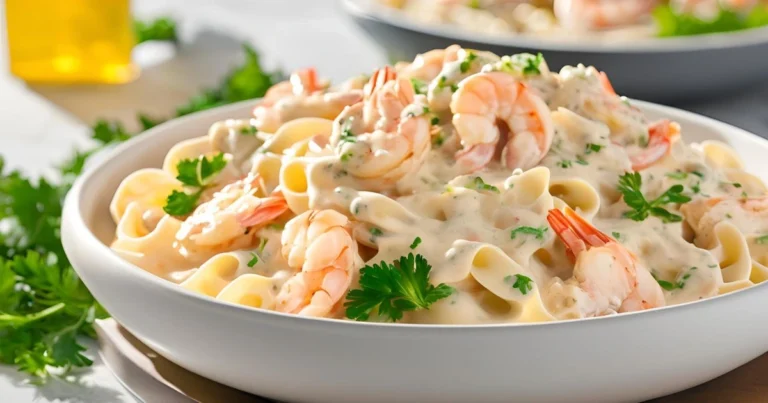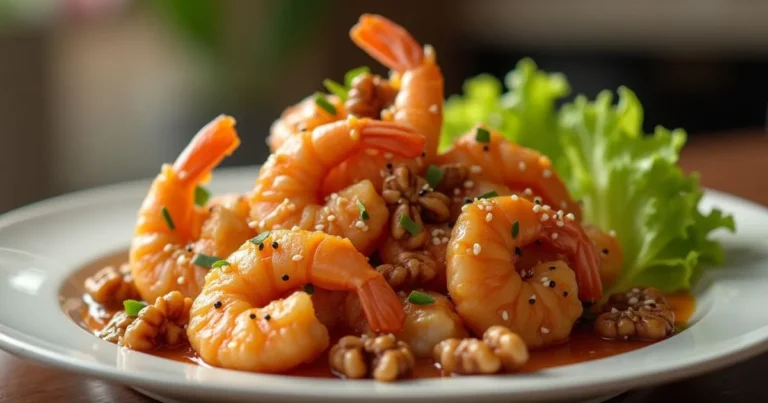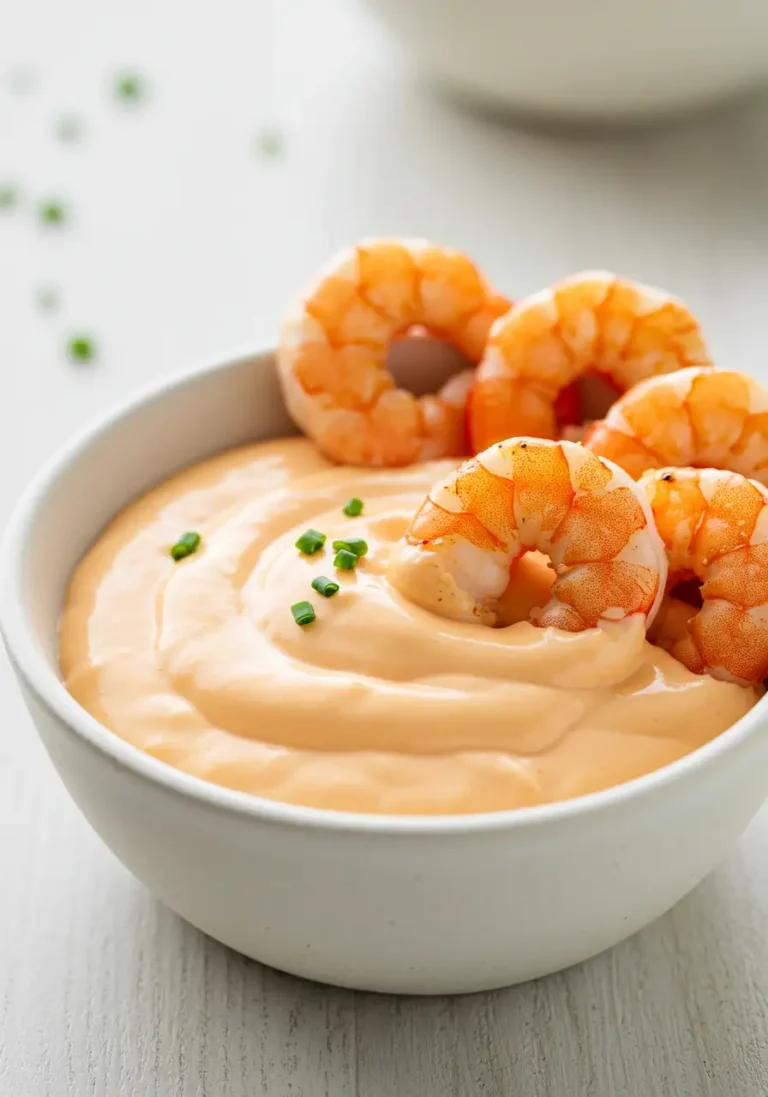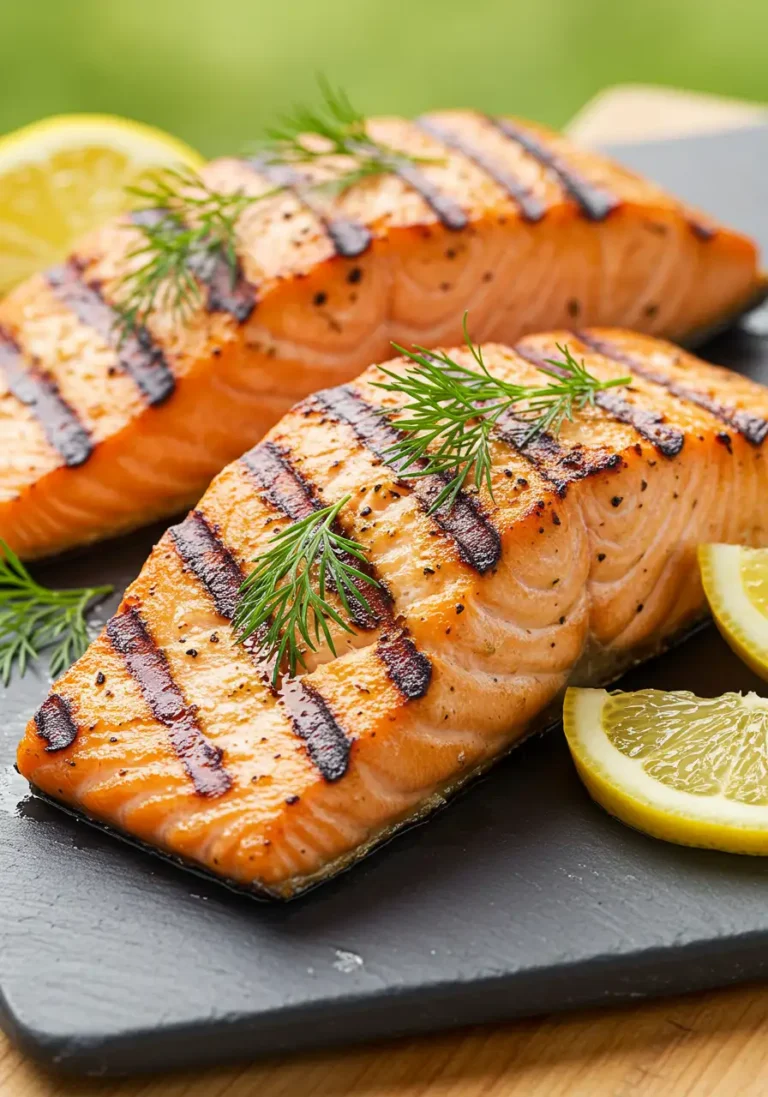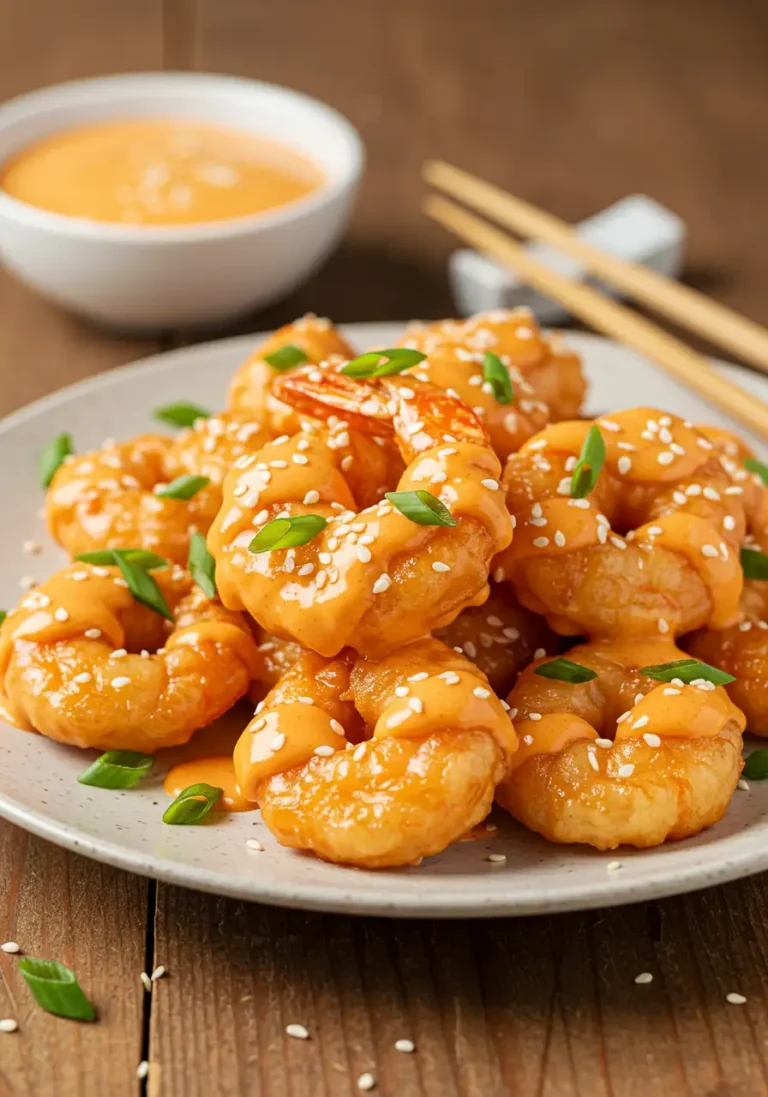How to Make Shrimp Fried Rice Recipe in 30 Minutes – Easy Hack!
Picture this: It’s 6:30 PM on a Wednesday. You walk through your front door after a marathon day at work, and immediately hear the familiar chorus of “What’s for dinner?” echoing from the kitchen. Your energy reserves feel completely depleted, yet your family needs a satisfying meal. You peek inside your refrigerator and discover some leftover rice, frozen shrimp tucked away in the freezer, and a medley of vegetables waiting to be transformed.
What if someone told you that these humble ingredients could become a restaurant-quality masterpiece in just thirty minutes?
My grandmother first shared this transformative shrimp fried rice recipe with me during one of those overwhelming weeknights when takeout seemed like the only viable solution. Her weathered hands moved with practiced precision as she demonstrated techniques passed down through generations. That evening changed everything – this recipe became our family’s ultimate comfort food solution, rescuing countless dinner dilemmas with its perfect balance of convenience and flavor.
Tonight, you can experience this same culinary revelation.
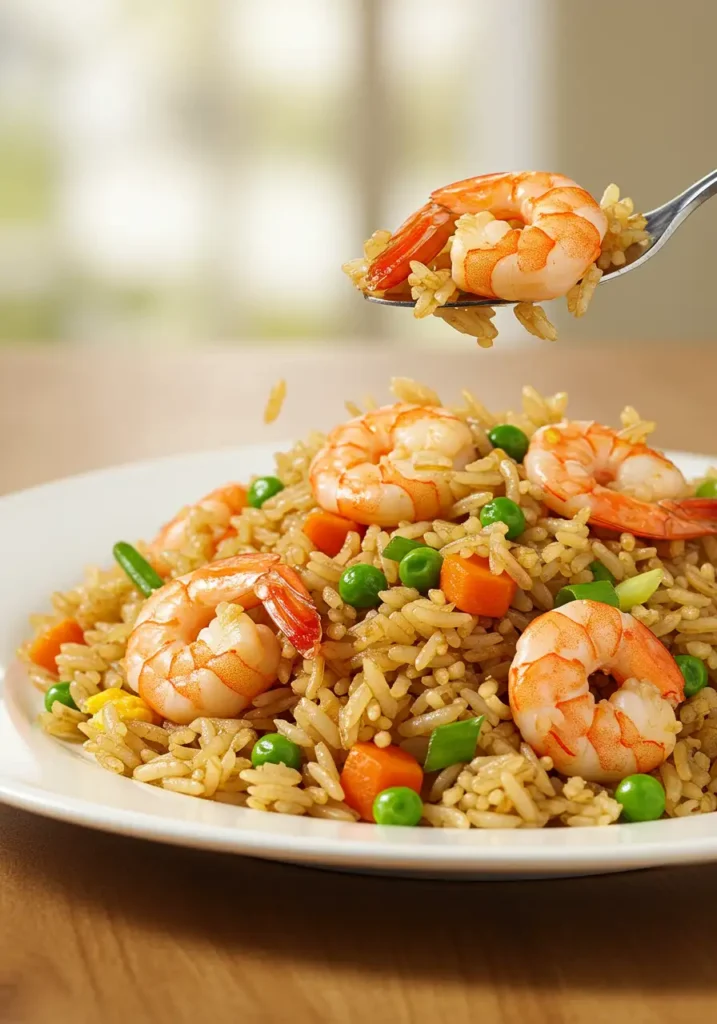
Why This Shrimp Fried Rice Recipe Will Revolutionize Your Kitchen
Your weeknight cooking routine deserves an upgrade, and this shrimp fried rice recipe delivers exactly that transformation. Unlike complicated dishes that demand hours of preparation, this method respects your time constraints while delivering exceptional results.
Consider the economics: restaurant-quality shrimp fried rice typically costs $12-15 per serving at your local Asian restaurant. Your homemade version costs approximately $3.50 per generous portion while providing superior nutritional value and customization options. You control every ingredient, ensuring freshness and quality that surpasses most commercial alternatives.
This recipe accommodates various dietary preferences effortlessly. Gluten-sensitive family members can enjoy tamari-based versions, while health-conscious eaters appreciate the balanced macronutrient profile. Children gravitate toward the mild flavors and colorful presentation, making dinner negotiations significantly easier.
Essential Ingredients for Exceptional Shrimp Fried Rice
Success begins with proper ingredient selection. Your shrimp fried rice recipe depends on quality components that harmonize beautifully when combined with correct techniques.
Main Components
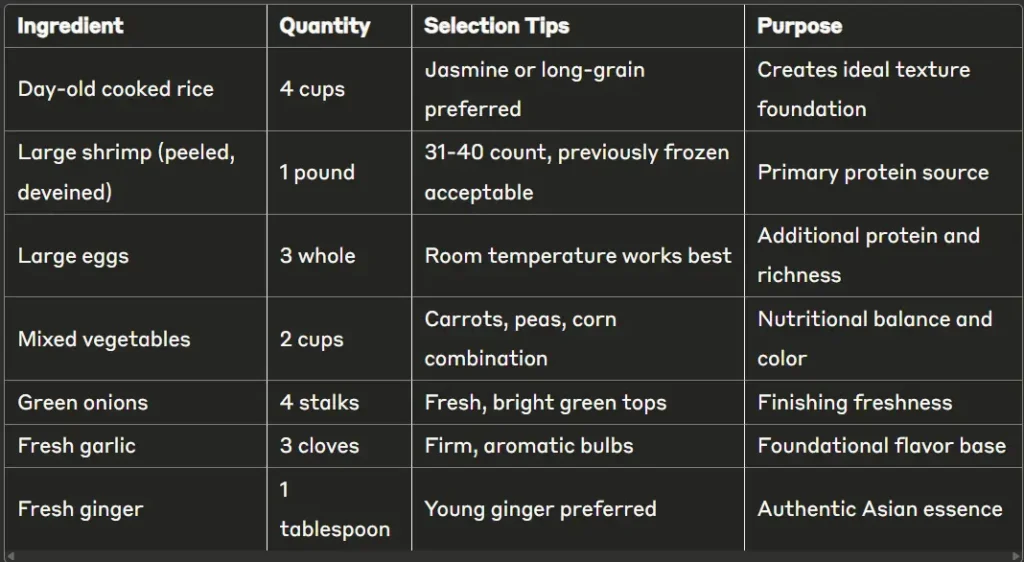
Sauce and Seasoning Arsenal

Shopping tip: Purchase shrimp from reputable fishmongers or frozen sections of established grocery chains. Previously frozen shrimp often provides better value and consistent quality compared to supposedly “fresh” alternatives that may have been sitting for days.
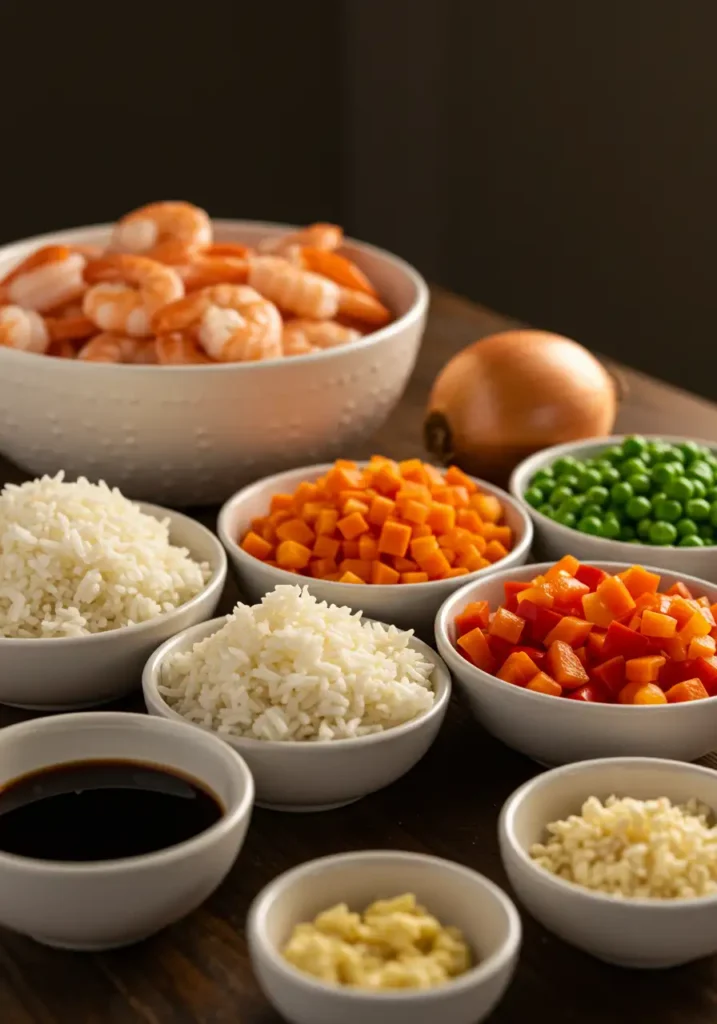
Step-by-Step Mastery: Your Shrimp Fried Rice Recipe Journey
Preparation Phase (10 Minutes)
Organization determines success in wok cooking. Asian chefs call this “mise en place” – having everything ready before heat touches the pan.
Ingredient Preparation:
- Rice handling: Break apart any clumps using your fingers or a fork. Cold, day-old rice prevents mushiness during stir-frying.
- Shrimp preparation: Pat each piece completely dry with paper towels. Moisture creates steam, preventing proper searing. Season lightly with salt and white pepper.
- Vegetable prep: Dice vegetables into uniform pieces roughly the size of rice grains. Consistency ensures even cooking throughout your shrimp fried rice recipe.
- Aromatics: Mince garlic and ginger finely. Their oils release quickly under high heat, so smaller pieces prevent burning.
- Sauce mixing: Combine soy sauce, oyster sauce, and half the sesame oil in a small bowl. This prevents fumbling during the rapid cooking process.
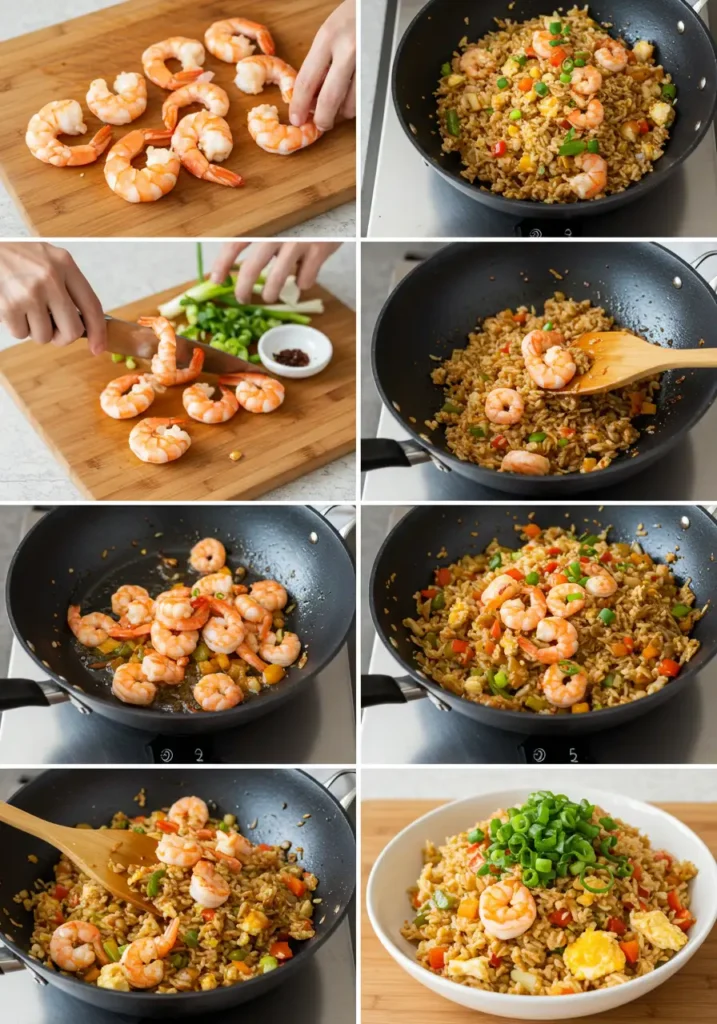
Cooking Execution (20 Minutes)
High heat transforms ordinary ingredients into extraordinary results. Your burner should run at maximum output throughout this process.
Phase One: Protein Cooking (5 minutes)
Heat your largest skillet or wok until wisps of smoke appear. Add two tablespoons of cooking oil, swirling to coat the surface completely.
Add seasoned shrimp in a single layer, avoiding overcrowding. Resist the urge to move them immediately – proper searing requires patience. After 90 seconds, flip each piece. The first side should display beautiful golden-brown caramelization.
Cook the second side for another minute until the shrimp develops a slight char while maintaining tenderness. Transfer to a clean plate and set aside.
Pour beaten eggs into the same hot pan. Allow them to set briefly before scrambling with a wooden spoon. Remove when still slightly wet – residual heat completes the cooking process.
Phase Two: Flavor Foundation (3 minutes)
Add remaining oil if the pan appears dry. Introduce minced garlic and ginger, stirring constantly for 30 seconds until fragrant. These aromatics form the flavor backbone of your shrimp fried rice recipe.
Add diced vegetables next, maintaining constant motion with your spatula. The goal involves achieving tender-crisp texture – cooked through but retaining slight bite.
Phase Three: Rice Integration (8 minutes)
This stage separates amateur attempts from professional results. Add cold rice to the pan, using your spatula to break apart stubborn clumps. Spread rice evenly across the pan’s surface, allowing direct contact with the hot metal.
Let the rice sit undisturbed for 60 seconds, creating slight crispiness on the bottom layer. Then stir vigorously, redistributing the mixture. Repeat this process twice more – the alternating rest and stirring technique develops complex textures and flavors.
Phase Four: Final Assembly (4 minutes)
Return cooked shrimp and scrambled eggs to the pan. Pour the prepared sauce mixture over everything, using your spatula to distribute evenly. The sauce should coat each grain without creating soggy patches.
Add sliced green onions and remaining sesame oil during the final minute. These finishing touches provide bright color contrast and aromatic complexity that elevates your shrimp fried rice recipe from good to exceptional.
Professional Techniques for Restaurant-Quality Results
Temperature Control Mastery
Successful fried rice demands aggressive heat management. Your pan should maintain temperatures between 400-450°F throughout cooking. If ingredients stop sizzling when added, increase heat immediately.
Professional kitchens use BTU outputs far exceeding home ranges, but you can compensate through proper technique. Preheat your pan thoroughly before adding oil, and never reduce heat during cooking phases.
Texture Development Secrets
The coveted “wok hei” flavor comes from high-heat cooking that slightly chars ingredients while preserving their essential character. Day-old rice provides the ideal moisture content – fresh rice contains too much water and becomes mushy under high heat.
Your rice should develop golden-brown patches while remaining fluffy and separate. If grains start clumping together, increase heat and stir more aggressively.
Timing Coordination
Stir-frying happens rapidly, leaving little room for corrections. Practice your mise en place until ingredient additions become automatic. Professional cooks can execute this shrimp fried rice recipe in under fifteen minutes because every component gets added at precisely the right moment.
Nutritional Benefits That Matter
Your homemade shrimp fried rice recipe delivers impressive nutritional value alongside exceptional taste. Each generous serving provides approximately:
- 380 calories with balanced macronutrient distribution
- 28 grams high-quality protein supporting muscle maintenance and satiety
- 45 grams complex carbohydrates offering sustained energy release
- 12 grams healthy fats primarily from sesame and cooking oils
- Essential vitamins and minerals including vitamin B12, selenium, and vitamin A
Restaurant versions often contain 600+ calories per serving due to excessive oil usage and larger portions. Your controlled preparation method reduces caloric density while maximizing nutritional benefit.
Shrimp provides all essential amino acids while remaining naturally low in saturated fat. The mixed vegetables contribute fiber, antioxidants, and micronutrients often lacking in takeout alternatives.
Customization Options for Every Preference
Dietary Adaptations
Gluten-Free Version: Substitute tamari for regular soy sauce. Verify your oyster sauce contains no wheat-based thickeners – many premium brands offer gluten-free alternatives.
Low-Carb Alternative: Replace rice with cauliflower rice, adding it during the final cooking phase to prevent overcooking. This modification reduces carbohydrates by approximately 75% while maintaining satisfying volume.
Vegetarian Transformation: Eliminate shrimp and double the egg quantity, or substitute firm tofu cut into small cubes. Press tofu thoroughly before cooking to remove excess moisture.
Flavor Variations
Thai-Inspired Version: Include fish sauce, Thai basil, and crushed red pepper flakes. Add a squeeze of fresh lime juice before serving.
Korean Fusion: Incorporate kimchi and a tablespoon of gochujang paste for spicy, fermented complexity.
Tropical Twist: Add diced pineapple and a pinch of curry powder for sweet-savory balance reminiscent of Hawaiian fried rice.
Storage and Meal Prep Strategies
Your shrimp fried rice recipe excels at meal preparation, maintaining quality for several days when stored properly. Cool completely before refrigerating in airtight containers – this prevents condensation that creates soggy textures.
Properly stored fried rice remains fresh for up to four days in your refrigerator. For longer storage, freeze portions in individual containers for up to three months. Frozen fried rice reheats beautifully in a hot skillet with a splash of water or broth.
When reheating, use medium heat and stir frequently to prevent sticking. Add a small amount of soy sauce or sesame oil if the rice appears dry.
Frequently Asked Questions
Can fresh rice work in this shrimp fried rice recipe? While day-old rice produces superior results, fresh rice can substitute if cooled completely and spread on a baking sheet to remove excess moisture. Refrigerate for at least 30 minutes before using.
How do I prevent rubbery shrimp? Overcooking causes rubber-like texture. Remove shrimp from heat immediately when they turn opaque pink throughout. They continue cooking slightly from residual heat.
What’s the best rice variety for fried rice? Long-grain varieties like jasmine or basmati create individual, fluffy grains that resist clumping. Short-grain rice tends to become sticky and doesn’t achieve the desired texture.
Can I prepare ingredients in advance? Absolutely! Prep vegetables and aromatics up to two days ahead. Season shrimp up to 24 hours before cooking. Having everything ready makes execution smooth and stress-free.
Transform Tonight’s Dinner Experience
This shrimp fried rice recipe represents more than just another weeknight meal – it’s your gateway to confident home cooking that rivals professional kitchens. The techniques you master here translate to countless other stir-fry dishes, expanding your culinary repertoire exponentially.
Start gathering your ingredients now. Your family deserves this restaurant-quality experience, and you deserve the satisfaction of creating something truly special with your own hands. In thirty minutes, you’ll understand why this recipe has transformed countless dinner routines.
Ready to revolutionize your weeknight cooking? Heat up that pan, grab your spatula, and let this incredible shrimp fried rice recipe become your new dinner hero. Your taste buds – and your family – will thank you for taking this delicious leap.
Have you tried our recipe yet?
There are no reviews yet. Be the first one to write one.

